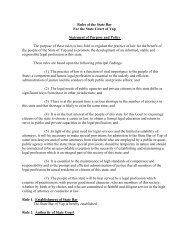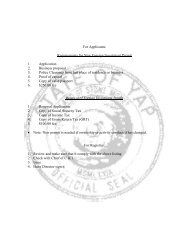CORRIGENDUM No. 2 - Yap State Government
CORRIGENDUM No. 2 - Yap State Government
CORRIGENDUM No. 2 - Yap State Government
Create successful ePaper yourself
Turn your PDF publications into a flip-book with our unique Google optimized e-Paper software.
Table 3: 80 W module data<br />
Rated Power<br />
80W<br />
Power Tolerance ± 5%<br />
<strong>No</strong>minal Voltage<br />
12V<br />
Maximum Power Voltage, V mp 17.6V<br />
Maximum Power Current, I mp 4.55A<br />
Open Circuit Voltage, V oc 22.1V<br />
Short Circuit Current, I sc 4.8A<br />
NOCT<br />
47±2°C<br />
Current at 14V and NOCT 4.75A<br />
Assuming a 5% dirt derating then the adjusted output current of the above module is:<br />
ADJUSTED<br />
Module current = I (NOCT) x 0.95 ( ← minus 5% for manufactures tol) x 0.95 ( ← minus 5% for dirt)<br />
= 4.75A x 0.95 x 0.95 = 4.29A<br />
NUMBER OF MODULES REQUIRED IN ARRAY<br />
First determine number of modules in series, To do this divide the system voltage by the nominal operating<br />
voltage of each module. In our example:<br />
For the worked example Number of modules in series = 24V ÷ 12V = 2<br />
Therefore the array must comprise of series connected strings of 2 modules.<br />
To determine the number of strings in parallel, the PV array output current required (in A) is divided by the<br />
output of each module (in A).<br />
For the worked example Number of strings in parallel =18.1A ÷ 4.29A = 4.22<br />
Do we round up or down If you want to be conservative you would round up. However in this example we<br />
suggest you round down since this calculation was based on the worst month and we allowed an oversize of<br />
10%.This does need to be determined for each system.<br />
For the worked example The number of modules in the array = 4 x 2 = 8<br />
The peak rating of the array is : 8 x 80W P = 640W P<br />
INVERTER SELECTION<br />
The type of inverter selected for the installation depends on factors such as cost, surge requirements, power<br />
quality and for inverter/chargers, a reduction of the number of system components necessary. Inverters are<br />
available in 3 basic output types - Square wave, modified square wave and sine wave.<br />
There are few square wave inverters used today.<br />
Modified square wave inverters generally have good surge and continuous capability and are usually cheaper<br />
than sine wave types. However, some appliances, such as audio equipment, television and fans can suffer<br />
because of the output wave shape.<br />
Sine wave inverters often provide a better quality power than the 230V (or 110V or 120V) grid supply.<br />
Issue 1 September 2012 Page 9
















